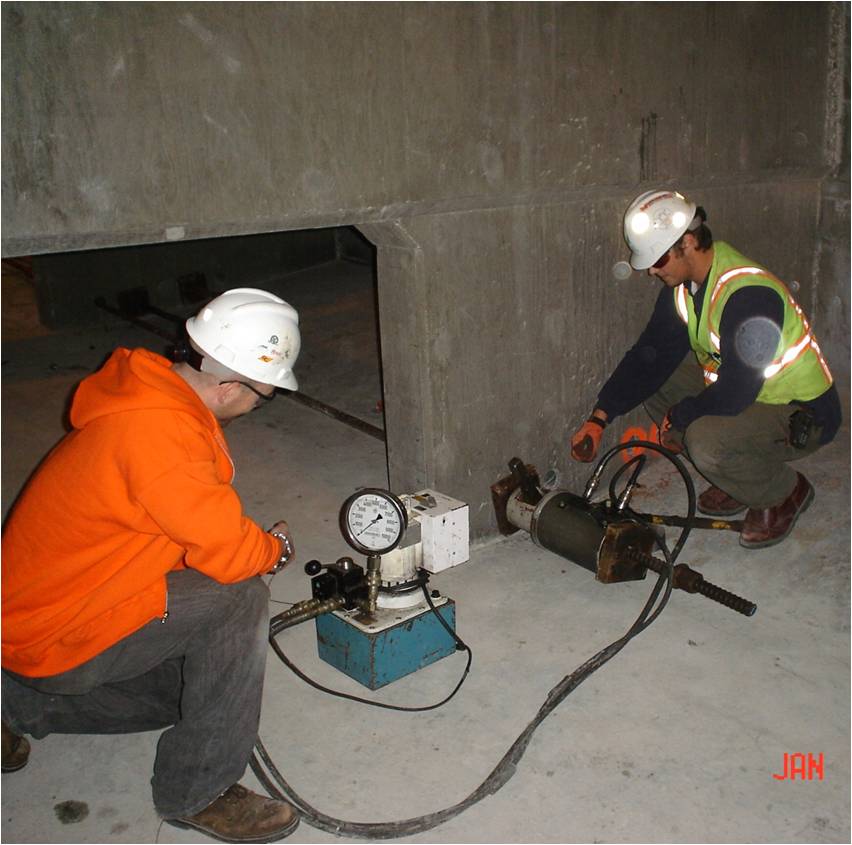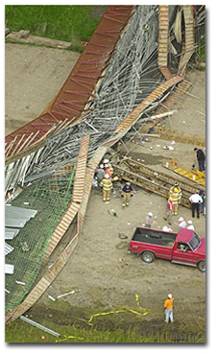3.2 Construction Safety Standards - Concrete And Masonry

This quiz is designed to test employee knowledge of construction safety pertaining to concrete and masonry.
- 1.
When should a Concrete Mason wear a respirator?
- A.
When it is dusty
- B.
When we have determined that the concentration of dust would require the employee to wear a proper respirator
- C.
After the employee complains about the dusty conditions
- D.
No respirator is required for a Concrete Mason
Correct Answer
B. When we have determined that the concentration of dust would require the employee to wear a proper respiratorExplanation
A Concrete Mason should wear a respirator when it has been determined that the concentration of dust would require the employee to do so. This implies that there is a specific threshold or level of dust concentration that has been established, and once it reaches or exceeds that level, the Concrete Mason should wear a respirator for their safety and protection. This indicates that the decision to wear a respirator is based on an objective assessment of the dust concentration rather than subjective factors such as the employee's complaints or general dusty conditions.Rate this question:
-
- 2.
“_____________________ shall be permitted to be behind the jack during tensioning operations.”
- A.
Supervisor
- B.
Laborer
- C.
Inspector
- D.
No Employee
Correct Answer
D. No EmployeeExplanation
During tensioning operations, it is important to ensure the safety of all personnel involved. Having any employee behind the jack can pose a significant risk as they may be in the line of force and could potentially get injured. Therefore, it is necessary to prohibit the presence of any employee behind the jack during tensioning operations to prevent accidents and ensure a safe working environment.Rate this question:
-
- 3.
Which of the following are hazards of post tensioning? (Mark all that apply)
- A.
Stored energy
- B.
Lacerations
- C.
Impalement
- D.
Pinch Points
- E.
Hydraulic Failure
Correct Answer(s)
A. Stored energy
B. Lacerations
C. Impalement
D. Pinch Points
E. Hydraulic FailureExplanation
Post tensioning involves the use of high tensioned steel cables or tendons, which store a significant amount of energy. If these cables are not handled properly, they can release stored energy suddenly, causing serious accidents and injuries. Lacerations can occur if workers come into contact with the sharp edges of the tendons or other equipment during the tensioning process. Impalement is a hazard when workers are exposed to protruding tendons or other sharp objects. Pinch points can occur when tendons are being tensioned or released, posing a risk of crushing or trapping body parts. Hydraulic failure can lead to sudden release of tension, causing potential hazards.Rate this question:
-
- 4.
“______________________ shall be erected to limit employee access to post tensioning area during tensioning operations.”
- A.
Signs and barriers
- B.
Caution Tape
- C.
Scaffolding
- D.
Trenches
Correct Answer
A. Signs and barriersExplanation
Signs and barriers should be erected to limit employee access to the post tensioning area during tensioning operations. This is important for safety reasons as post tensioning operations can be hazardous and pose risks to employees. Signs can provide clear instructions and warnings, while barriers can physically restrict access to the area, ensuring that only authorized personnel are allowed near the tensioning operations. This helps to prevent accidents and injuries by keeping employees at a safe distance from the potentially dangerous work being carried out.Rate this question:
-
- 5.
How big does a limited access zone need to be for construction of a masonry wall?
- A.
4 feet around wall
- B.
Large enough to allow for scaffolding
- C.
The height and the entire width of the wall
- D.
The height and width of the wall plus a four foot safety zone
Correct Answer
D. The height and width of the wall plus a four foot safety zoneExplanation
A limited access zone needs to be the height and width of the wall plus a four-foot safety zone. This is necessary to ensure that there is enough space for workers to safely construct the masonry wall and also to provide a buffer zone for any potential hazards or falling debris. By including the safety zone, it helps to prevent accidents and injuries by keeping workers and equipment at a safe distance from the construction area.Rate this question:
-
- 6.
“All masonry walls over _____ feet in height shall be adequately braced to prevent overturning.”
- A.
8
- B.
6
- C.
5
- D.
4
Correct Answer
A. 8Explanation
Masonry walls over 8 feet in height need to be adequately braced to prevent overturning. This is because taller walls have a greater risk of collapsing or toppling over due to the weight and pressure they bear. Bracing helps to distribute the forces and stabilize the wall, ensuring its structural integrity and safety. Walls below this height may still require some form of bracing, but it is explicitly mandated for walls exceeding 8 feet.Rate this question:
-
- 7.
“Erected shoring equipment shall be inspected_____________.”
- A.
Immediately prior to concrete placement
- B.
During concrete placement
- C.
Immediately after concrete placement
- D.
All of the Above
Correct Answer
D. All of the AboveExplanation
The correct answer is "All of the Above" because according to the given statement, the shoring equipment should be inspected immediately prior to concrete placement, during concrete placement, and immediately after concrete placement. This ensures that the equipment is in proper condition and can effectively support the concrete structure during the construction process.Rate this question:
-
- 8.
When can a construction load be placed on a concrete structure?
- A.
"After the pour, it is safe to place a load"
- B.
"The next day, it is safe to place a load"
- C.
When the employer determines it is safe through inspection and data
- D.
"After 7 days, it is safe to place a load"
Correct Answer
C. When the employer determines it is safe through inspection and dataExplanation
The correct answer is "When the employer determines it is safe through inspection and data." This answer suggests that the decision to place a construction load on a concrete structure should be based on the employer's assessment of safety, which is determined through inspection and data. This implies that the employer should evaluate the structural integrity of the concrete and ensure that it can withstand the load before proceeding.Rate this question:
-
- 9.
How much weight are lifting inserts on precast concrete required to be capable of supporting?
- A.
Must be able to support the intended load
- B.
Able to support 4 times the load
- C.
Able to support 2 times the load
- D.
None of the Above
Correct Answer
B. Able to support 4 times the loadExplanation
The lifting inserts on precast concrete are required to be capable of supporting 4 times the load. This is because the inserts need to have a higher weight capacity in order to ensure the safety and stability of the precast concrete elements during lifting and transportation. By having a weight capacity that is four times the intended load, it provides a sufficient safety margin to account for any potential variations in the actual load or unforeseen circumstances that may occur during the lifting process.Rate this question:
-
- 10.
What reinforcing steel needs to be guarded with caps to protect from impalement?
- A.
All vertical rebar that could be fallen on to
- B.
All horizontal rebar that could be fallen on to or could create an abrasion hazard
- C.
Both A and B
- D.
None of the Above
Correct Answer
C. Both A and BExplanation
Both vertical and horizontal reinforcing steel needs to be guarded with caps to protect from impalement. Vertical rebar that could be fallen on to can pose a risk of impalement if not properly protected. Similarly, horizontal rebar that could be fallen on to or could create an abrasion hazard should also be guarded with caps to prevent any potential injuries. Therefore, both options A and B are correct.Rate this question:
-
Quiz Review Timeline +
Our quizzes are rigorously reviewed, monitored and continuously updated by our expert board to maintain accuracy, relevance, and timeliness.
-
Current Version
-
Mar 22, 2023Quiz Edited by
ProProfs Editorial Team -
Dec 29, 2008Quiz Created by
Kiewit
- Back Safety Quizzes
- Chemistry Safety Quizzes
- Drill Press Safety Quizzes
- Electrical Safety Quizzes
- Fire Safety Quizzes
- General Safety Quizzes
- Kitchen Safety Quizzes
- Laboratory Safety Quizzes
- Lathe Safety Quizzes
- Office Safety Quizzes
- Online Safety Quizzes
- Patient Safety Quizzes
- Radiation Safety Quizzes
- Safe Lifting Quizzes
- Sander Safety Quizzes
- Saw Safety Quizzes
- Shop Safety Quizzes
- Work Safety Quizzes
- Workplace Safety Quizzes
 Back to top
Back to top






